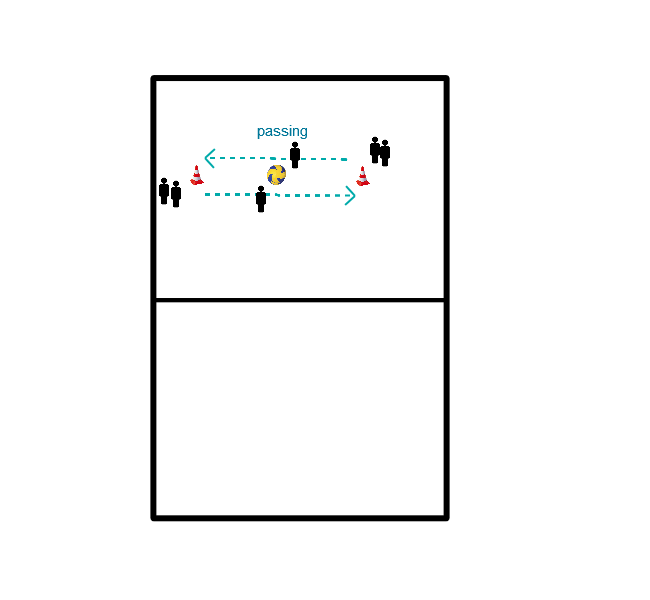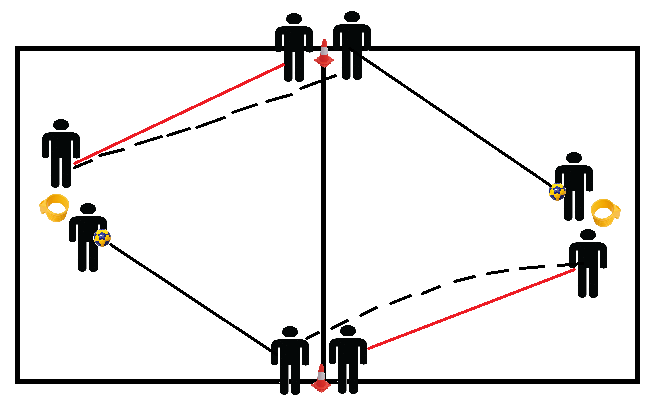Korfball drills for technique passing / attack
- 1 person under the pole.
- 2 persons in front of the post, attacker/defender.
- Ball is played out on the attacker who moves sideways.
- He receives the ball on the outer hand.
- The defender steps over and then the attacker takes the ball over and plays in.
- The attacker dodges and does the same again with the other hand.
- The attacker then dodges again and tries to shoot.
- The defender runs along but allows the pass and the shot to happen.
- Later on, the defender can choose whether to allow the pass or the shot.
- It is then up to the attacker to time well.
- Take care that players do not run into each other.
- This applies especially to younger teams.
- You make a box, with an attacker in it,
- the attacker must keep moving in the box, while a defender is following.
- The other player is standing outside the box.
- The attacker starts with the ball in his/her hands and throws it to someone on the side and the person on the side throws it back to the attacker and then throws it back to someone else standing on the side.
- The defender tries to take the ball.
- When the defender takes the ball, he throws it back you will try again
- The attacker always tries to run free and the defender tries to intercept the ball
- Per group: a post and a ball, the posts are preferably (but not absolutely necessary) arranged in a circle or rectangle.
- The number of persons per group is less important (but all groups are about the same size).
- The first task for the groups is to score 10 goals with a through-ball.
- When you have finished with that, the person who scored the last goal runs to the trainer to get the next task. Which group performed all the tasks first?
- The trainer has a piece of paper with tasks on him.
- When someone comes to get the next task, first ask which task has just been completed (this can vary considerably over time) and then give the next task.
- List:
- 5 through-balls,
- 5 penalty throws,
- Five 3-meter shots,
- 5 shots from 3 meters behind the post.
Create a box with an attacker inside.
- The attacker has to keep moving in the box while a defender is running.
- Someone always plays the ball.
- The defender looks at the ball and tries to catch it
- Every time the attacker catches the ball, someone enters the box.
- When the defender picks up the ball, he throws it back and tries again
- The ball is thrown in a circle.
- A child starts behind the person standing next to the person with the ball.
- The ball must be overtaken.
- The rest has to make sure that the ball is thrown over.
- Place two posts where they usually are during a game.
- Then place two pilons at the far left and far right on the center line.
- Ideally, this exercise is done with 8 people, more is possible, less than 8 doesn't work.
- At each post or pilon two people are standing, one person under the post starts with the ball (on both sides).
- This person throws the ball to someone near the pilon on his right and runs after the ball.
- This person then throws the ball to the other post, and the second person near the pilon goes for a through-ball.
- Now the ball is under the post again and the round starts over again.
Arrangement:
(Black line: throwing and running after the ball) (Black dotted line: throwing ball) (Red line is running for a through-ball)
- 4 posts and 4 groups,
- 2 Balls: aim to think how to run freely when building up.
- 4 versus 4 with 2 posts:
- trying to throw a long ball when building up by running deep,
- running free through tempo change.
- Pause a few times to discuss running free and tempo changes;
- learning to find an angle,
- or when the angle is fixed, the long diagonal throw.
- 2 posts and 3 groups,
- defending party intercepts,
- builds up and goes on to attack the box;
- Build up starts in defence!
- You put up four poles in a square,
- in the middle of the four poles you put down a pilon.
- four children will be passers at the poles and
- the rest of the children will stand by the pilon in the middle.
- First, you can choose that the attackers have to take through-balls at the poles.
- It doesn't matter which pole, they may run at the same pole a maximum of 2 times in a row.
- You can choose this, so they have to run a lot.
- The children also have to score twice, the person who does this first may definitely switch positions with a passer, the other may switch as well as soon as they score twice.
- After that you can choose to let the children do free balls, penalty throws, dodge-balls, etc.

- Put pilons about 6 meters apart. Divide the group into 2.
- In the case of five, one group of 3 and a group of two.
- The goal is to keep the ball in the middle between the pilons at all times.
- As soon as a player receives the ball, the player must be at the centre of the other side.
- After you have passed the ball, you join the back row on the opposite side.
- NB: Nobody stands still and tries to see what happens at all times
- Do not arrive too early or too late.
- Throwing while moving.
- After five minutes switch side (left hand).
- Make pairs, at each post a pair.
- We are now going to use the posts lengthwise, namely one player of the pair attacks the post opposite to him or her.
- One player of the opposite post does the same.
- How does this work?
- Of each pair there is a number 1 and a number 2.
- Number 1 is going to defend his post for a minute and a half against the other number 1 of the post opposite to him.
- When the number 1 of a post has had a chance, the other number will attack and so there will be a change of function (and of post, because everyone is defending his own post).
- So there is always a change of function if the attacker has lost the ball.
- As a player, you are attacking as well as defending for a minute and a half
At a distance of +/- 15 meters from each other, make two compartments with 4 pilons of 1.5 x 1.5 meters.
Make two teams with an equal number of players.
- Each team has its own compartment.
- The other team tries to conquer the other team's square.
- This happens when 1 striker is standing in the opponent's square and the ball is played by a team-mate.
- They get 1 point. No other players are allowed in the box.
- When the defence intercepts the ball, they may immediately start the attack on the opponent's square.
Variation:
- on time
- with points
- of both teams 1 player is allowed in the box
- no limit on the number of defendants in box
- no limit on the number of attackers in box
- customize size of box
- distance between boxes
- Put 3 pilons in a triangle.
- At pilon 1 and 3, there's one person.
- Person at pilon 1 has a ball, person at pilon 3 runs to pilon 2 and runs back.
- Person at pilon 1 throws the ball when he or she arrives at the pilon, then the person at pilon 1 runs to pilon 2 and back again and gets the ball when he/she arrives at pilon 1 again. And so on.








